The Innovation Management Market is estimated to be valued at USD 1.5 billion in 2025 and is projected to reach USD 4.1 billion by 2035, registering a compound annual growth rate (CAGR) of 10.7% over the forecast period.
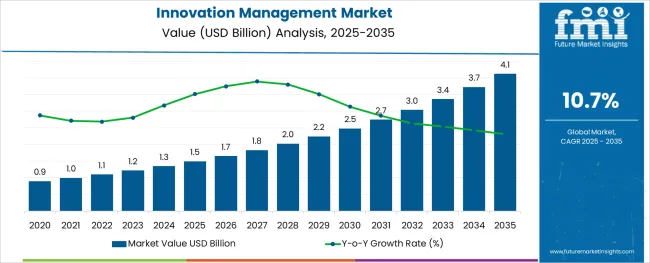
The innovation management market is gaining significant traction as organizations across industries prioritize continuous improvement, digital transformation, and structured idea generation to maintain competitiveness in rapidly evolving business landscapes.
Increasing demand for platforms that facilitate systematic innovation processes, from idea collection to product development and strategic decision-making, has reinforced market expansion.
Enterprises are recognizing the value of innovation management solutions not only in driving operational efficiency but also in fostering collaboration and enabling rapid market response.
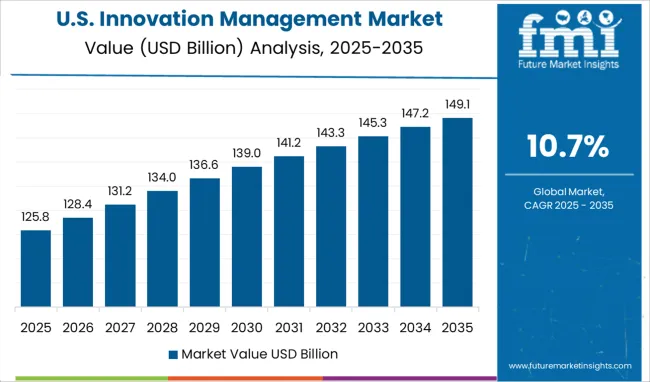
The market is segmented by Component, Organization Size, Deployment Mode, Vertical, and Function and region. By Component, the market is divided into Solutions and Services. In terms of Organization Size, the market is classified into Large Enterprises and Small and Medium-Sized Enterprises.
Based on Deployment Mode, the market is segmented into On-premises and Cloud. By Vertical, the market is divided into BFSI, Aerospace and Defense, Healthcare and Pharmaceuticals, Retail and eCommerce, Information Technology and Telecommunications, Government, Manufacturing, Transportation and Logistics, and Others.
By Function, the market is segmented into Product Development and Business Processes. Regionally, the market is classified into North America, Latin America, Western Europe, Eastern Europe, Balkan & Baltic Countries, Russia & Belarus, Central Asia, East Asia, South Asia & Pacific, and the Middle East & Africa.
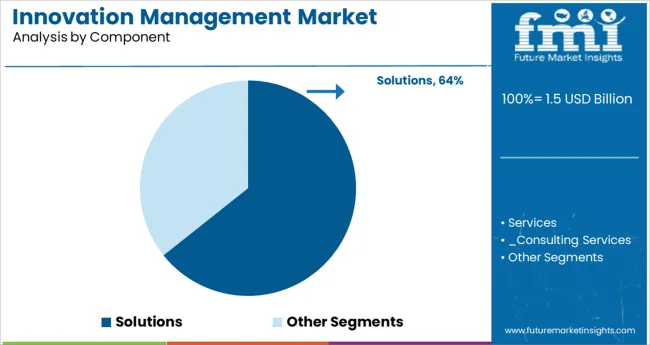
The solutions segment accounted for approximately 64.3% of the innovation management market, maintaining its leadership position within the component category.
The segment’s prominence is attributed to organizations’ rising reliance on structured platforms and software tools that support comprehensive innovation workflows, including idea generation, evaluation, portfolio management, and project execution.
Demand for tailored innovation management solutions has been driven by the need for scalable, configurable, and integrated systems capable of aligning innovation initiatives with broader corporate strategy.
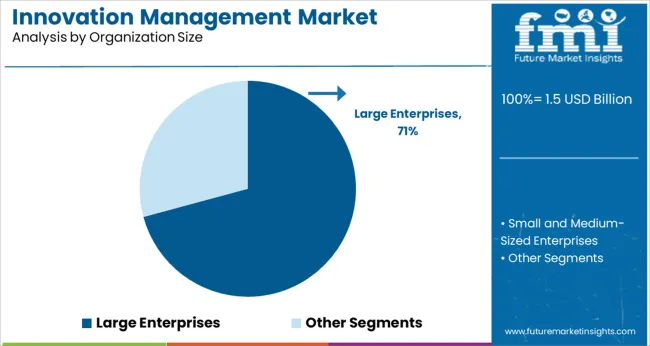
Within the organization size category, large enterprises led with a 70.8% market share, underscoring their substantial investment capacity and strategic focus on fostering innovation-led growth.
Large organizations have increasingly recognized the critical role of structured innovation management in navigating complex competitive environments, adapting to market disruptions, and sustaining long-term value creation.
The segment’s growth has been fueled by the adoption of enterprise-grade platforms capable of managing extensive idea pipelines, cross-departmental collaboration, and integration with corporate performance management systems.
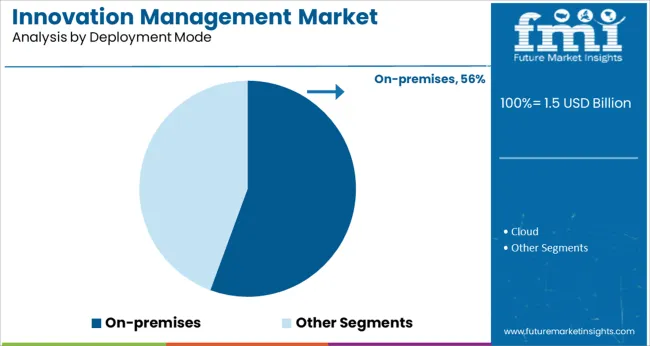
In the deployment mode category, the on-premises segment secured a commanding 55.6% market share, reflecting persistent demand for highly secure, customizable, and enterprise-controlled innovation management systems.
Despite the growing trend toward cloud-based solutions, several organizations, particularly in regulated industries and government sectors, continue to favor on-premises deployments due to concerns over data privacy, integration complexity, and system control.
The segment’s stability has been supported by enterprises with established IT infrastructure preferring to retain innovation management platforms within their internal networks to ensure compliance with stringent data governance and security protocols.
Open innovation is the sharing of ideas and knowledge among stakeholders, such as enterprise employees, business partners, the general public, and customers, in order to improve products, services, and business processes for a better customer experience and increased income.
Open innovation is comparable to crowd-sourcing innovation. It begins with product and service enhancement suggestions and progresses to open business model innovation. It establishes a strong connection between stakeholders, such as businesses, their staff, and their customers.
Enterprise management teams can predict ideas that can generate revenue and improve the customer experience based on the exchange of ideas. This would also help the company maintain its market competitiveness by increasing brand reliability. The ideas generated by crowd-sourcing can help businesses improve their operational efficiency.
Enterprises can improve their business processes by deploying innovation management systems. However, it has been shown that there are no quantifiable criteria for evaluating the return on investment (ROI) generated by the utilization of these innovation management products and services.
As a result, businesses that use innovation management solutions are unable to deliver consistent returns on investment. Innovation management systems must be integrated with various organizations' adopted strategies in order to determine particular Key Performance Indicators (KPIs) that can be used to track the level of stakeholder participation in innovations, such as consumers, partners, and employees.
To track and ascribe business value generated by innovations, companies must examine the appropriate KPIs in accordance with top-level management.
Almost every organization has undergone a digital transformation. The rapid advancement of technology has resulted in the development of a vast volume of data, which has increased the need for data storage and processing speed.
Innovation management systems have progressed practically in lockstep with technical advancement. Enterprises are making key decisions based on the ideas generated by various innovation management tools. The sectors could quickly increase their growth in the innovation management market if they take advantage of these enticing chances.
Despite the fact that innovation management solutions have improved in recent years, the market's information security capabilities remain a serious concern. Enterprises are highly cautious about their communication channels, such as emails, instant messaging, and mobile communication, as they have a direct impact on the security and privacy of company data.
The majority of clients are unaware of the long-term benefits of expanding the innovation management market. As a result, it demonstrates their unwillingness to contribute a larger sum during the initial agreement.
The innovation management market is segmented into function, component, organizational size, deployment type, verticals, and region.
Depending on the size of the organization, when compared to SMEs, large companies are more likely to use innovation management solutions. The rapid use of cloud-based innovation management solutions by SMEs around the world has grown.
With a predicted CAGR of 10.6%, services are the leading segment in the innovation management market. Consulting, system integration, and training, support, and maintenance are the three categories of innovation management services. Business consulting, maturity value consulting, business value consulting, business discovery, business alignment management, and business architecture management are some of the pre-deployment services offered by innovation management consulting services.
These consulting services assist businesses in using new technologies in order to transform their existing and traditional infrastructure into smart infrastructure.
In the global innovation management market, the cloud deployment category had the majority revenue share, with a predicted CAGR of 10.3%.
Cloud-based innovation management solutions are essential, as they provide a scalable and adaptable infrastructure for managing many devices and analyzing ideas from employees, customers, and partners.
Though cloud deployment makes it easier to implement innovation management solutions, it also comes with a number of significant challenges, including legal regulations, security and safety, operational control, reliability, transformation complexity, performance, content governance, and, most importantly, the promised Return on Investment (RoI) benefits.
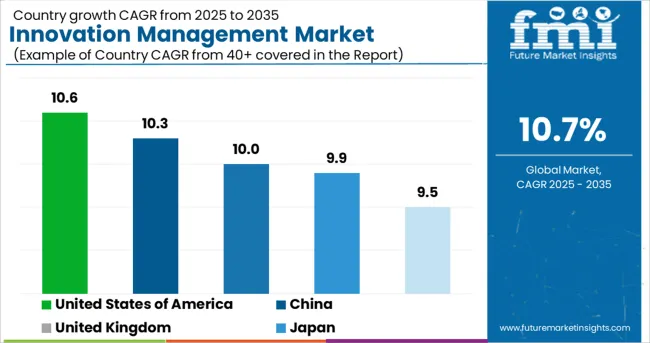
| Regions | CAGR (2025 to 2035) |
|---|---|
| United States of America | 10.6% |
| United Kingdom | 10% |
| China | 10.3% |
| Japan | 9.9% |
| South Korea | 9.5% |
North America is estimated to account for the largest share of the market, with a projected CAGR of 10.6%. At the same time, the Asia-Pacific region is expected to grow at the fastest rate during the forecast period. The considerable growth in the innovation management market in North America may be attributed to technological advancements and the growing demand for innovative products to meet customer needs.
According to the FMI report, individual market-affecting factors and changes in regulation in the domestic market are also discussed in the national portion of the research, which have an impact on the market's current and future trends. Downstream and upstream value chain analysis, technological trends, and case studies are just a few of the data pieces used to anticipate market scenarios for individual countries.
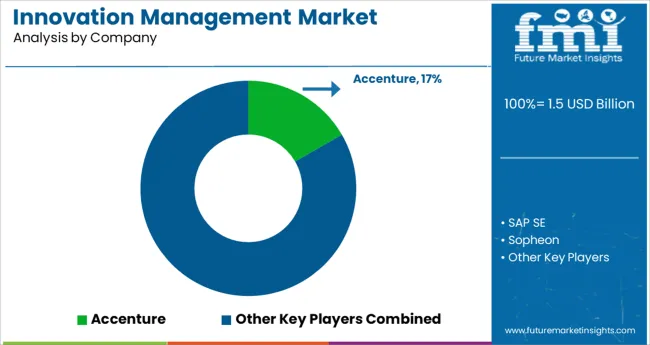
The development of innovative and efficient goods is the primary focus of players in the innovation management market. Research shows how the competitors are taking advantage of the opportunities present in the innovation management market.
Market companies continue to seek market expansion through a variety of important consolidations and acquisitions, advancement, developing interests in inventive work, and financially sound item portfolios. Some of the recent developments in the innovation management market are:
The global innovation management market is estimated to be valued at USD 1.5 billion in 2025.
It is projected to reach USD 4.1 billion by 2035.
The market is expected to grow at a 10.7% CAGR between 2025 and 2035.
The key product types are solutions, services, _consulting services, _system integration services and _training, support, and maintenance services.
large enterprises segment is expected to dominate with a 70.8% industry share in 2025.






Full Research Suite comprises of:
Market outlook & trends analysis
Interviews & case studies
Strategic recommendations
Vendor profiles & capabilities analysis
5-year forecasts
8 regions and 60+ country-level data splits
Market segment data splits
12 months of continuous data updates
DELIVERED AS:
PDF EXCEL ONLINE
Tax Management Market Size and Share Forecast Outlook 2025 to 2035
Key Management as a Service Market
Cash Management Supplies Packaging Market Size and Share Forecast Outlook 2025 to 2035
Fuel Management Software Market Size and Share Forecast Outlook 2025 to 2035
Risk Management Market Size and Share Forecast Outlook 2025 to 2035
SBOM Management and Software Supply Chain Compliance Market Analysis - Size, Share, and Forecast Outlook 2025 to 2035
Case Management Software (CMS) Market Size and Share Forecast Outlook 2025 to 2035
Farm Management Software Market Size and Share Forecast Outlook 2025 to 2035
Lead Management Market Size and Share Forecast Outlook 2025 to 2035
Pain Management Devices Market Growth - Trends & Forecast 2025 to 2035
Data Management Platforms Market Analysis and Forecast 2025 to 2035, By Type, End User, and Region
Cash Management Services Market – Trends & Forecast 2025 to 2035
CAPA Management (Corrective Action / Preventive Action) Market
Exam Management Software Market
Light Management System Market Size and Share Forecast Outlook 2025 to 2035
Labor Management System In Retail Market Size and Share Forecast Outlook 2025 to 2035
Waste Management Carbon Credit Market Size and Share Forecast Outlook 2025 to 2035
Waste Management Market Size and Share Forecast Outlook 2025 to 2035
Stool Management System Market Analysis - Size, Share, and Forecast Outlook 2025 to 2035
Power Management System Market Analysis - Size, Share, and Forecast Outlook 2025 to 2035

Thank you!
You will receive an email from our Business Development Manager. Please be sure to check your SPAM/JUNK folder too.
Chat With
MaRIA